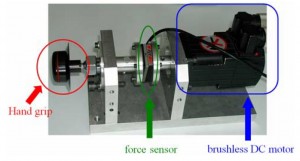Knobs and buttons are everywhere, on TVs, microwave ovens, washing machines, cookers, almost every domestic appliance. It is important from the users’ point of view that these controls are firm and responsive but carrying out tests on different kinds of knobs is hard before marketing a new product. Italian scientists have now developed a knob simulator that tests how easily a particular design is to grip or twist and the response users get when they press the buttons in the right way.
Writing in the International Journal of Advanced Mechatronic Systems, Valentina Colla of the Scuola Superiore Sant’Anna, in Pisa and Benedetto Allotta of the University of Florence, explain how many consumers judge a product by the quality of its knobs and buttons. They point out that while knob assessment is a rather subjective matter most users agree on certain qualities but identifying whether a particular knob fulfils the desires of hundreds if not thousands of users is usually not possible before a product reaches the marketplace.

Nevertheless, say the researchers, “When a customer is choosing a domestic appliance to acquire, one of the most common actions driving the decision process consists in manoeuvring its knobs and buttons.” This rough test does not necessarily reveal overall quality of a product, but inadequate knobs and buttons can easily deter a customer from buying a particular product.
The researchers have developed a mechatronic device that simulates a knob’s behaviour and so could be used to support an extensive campaign of end-users tests. Specifically, the simulator, which they describe as a haptic device, can allow designers to test different hand-grip behaviours with volunteers acting as potential buyers of a given product. The simulator consists of a brushless DC motor that can provide different levels of resistance to rotation, a force sensor, and a bush to which the knob to be tested can be attached. Different cams can be used to simulate different types of knob rotation, smooth, a definite click between positions or a response somewhere between those two.
The team says this successful feasibility could be extended to investigate stick-slip phenomena more deeply and to look at how friction affects knob simulation.
“Passivity control of a haptic device for the simulation of knobs” in Int. J. Advanced Mechatronic Systems, 2011, 3, 304-311